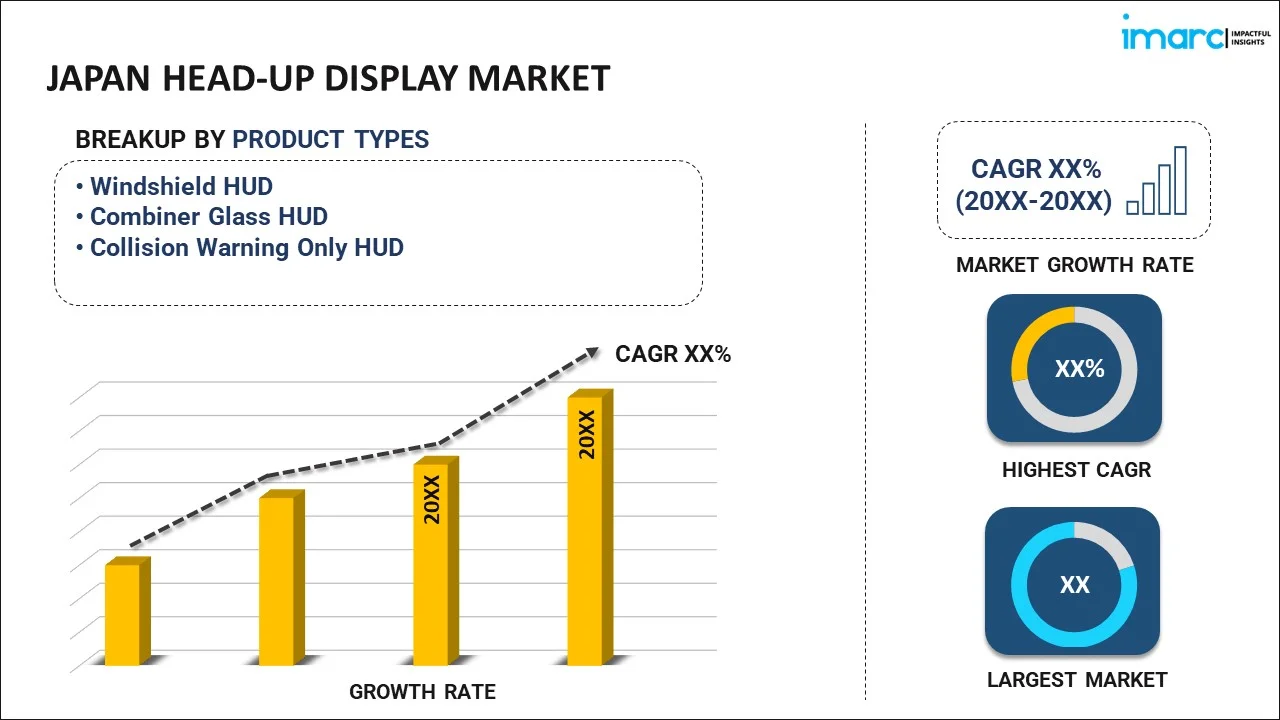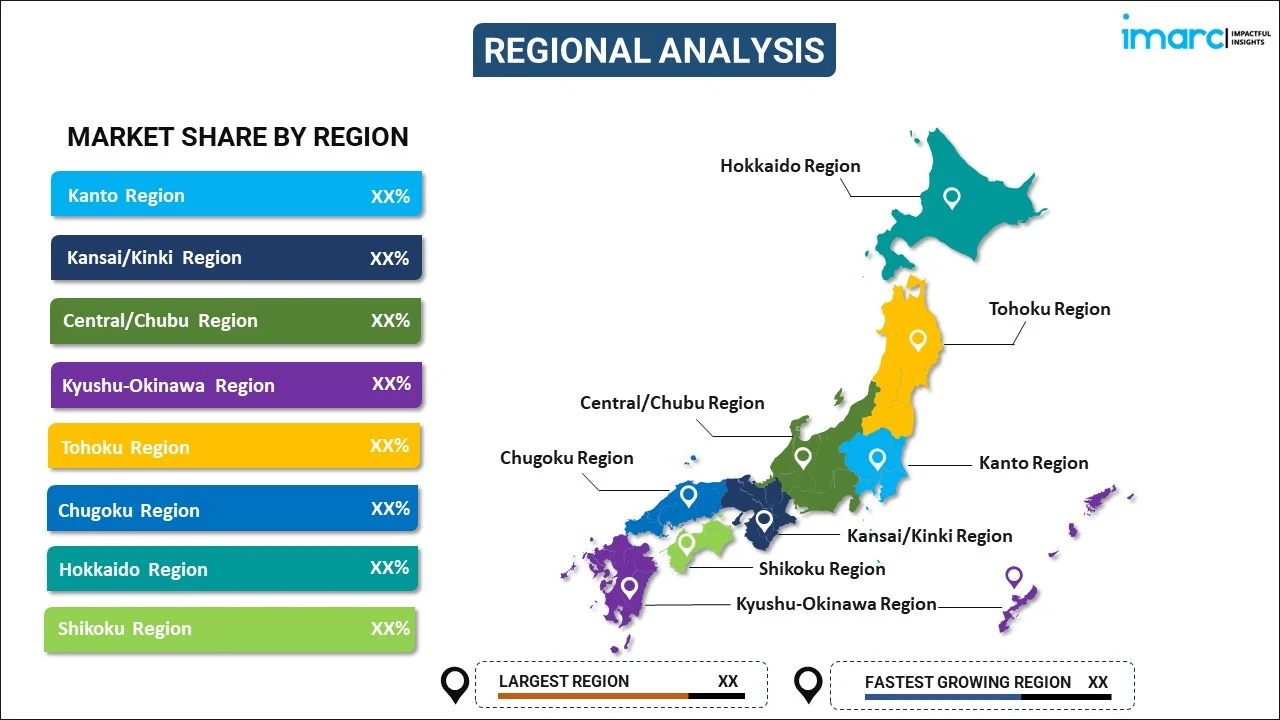
Japan Head-Up Display Market Report by Product Type (Windshield HUD, Combiner Glass HUD, Collision Warning Only HUD), Conventional and Augmented Reality (Conventional HUD, Augmented Reality Based HUD), Technology (CRT Based HUD, Digital HUD), Application (Aviation, Automotive), and Region 2025-2033
Market Overview:
Japan head-up display market size reached USD 70.7 Million in 2024. Looking forward, IMARC Group expects the market to reach USD 362.5 Million by 2033, exhibiting a growth rate (CAGR) of 18.43% during 2025-2033. The increasing focus on fuel efficient driving practices, along with the growing number of tech-savvy who expect a seamless integration of technology into their daily lives, including their vehicles, is primarily driving the market growth.
|
Report Attribute
|
Key Statistics
|
|---|---|
|
Base Year
|
2024
|
|
Forecast Years
|
2025-2033
|
|
Historical Years
|
2019-2024
|
| Market Size in 2024 | USD 70.7 Million |
| Market Forecast in 2033 | USD 362.5 Million |
| Market Growth Rate 2025-2033 | 18.43% |
A head-up display (HUD) is a digital interface designed to project essential information directly into the user's line of sight. This technology displays critical data like speed, navigation instructions, and warnings onto a vehicle's windshield or a transparent screen. Its primary objective is to reduce distractions and improve the driver's situational awareness by placing vital information within their natural field of vision. It operates by overlaying crucial data onto a transparent surface, enabling users to access important information without the need to shift their attention away from their primary task.
Japan Head-Up Display Market Trends:
The Japan head-up display market is primarily propelled by substantial growth within the automotive sector. This growth is further accentuated by various technological advancements taking place across the industry, which contribute to a positive market outlook. Additionally, the integration of augmented reality (AR) and micro-display imaging technologies into head-up display systems is gaining traction among end-users, offering new possibilities and opportunities for growth. Furthermore, the increasing frequency of road accidents has prompted leading players to make substantial investments in deploying HUD systems in mid-range car models, which is acting as another significant growth-inducing factor. Besides this, head-up display systems are also extensively used in aircraft to project crucial flight instrument data, further positively influencing the regional market. Moreover, the surging popularity of premium and luxury vehicles, coupled with rising disposable incomes among consumers, is catalyzing the market growth in Japan. As such, the rising awareness among the public regarding the advantages of head-up display technology, which includes improved concentration and faster decision-making, is also bolstering the market growth. Apart from this, the continuous innovation of HUD products and extensive research and development (R&D) activities undertaken by key industry players are expected to be pivotal in driving further market growth over the forecasted period.
Japan Head-Up Display Market Segmentation:
IMARC Group provides an analysis of the key trends in each segment of the market, along with forecasts at the country level for 2025-2033. Our report has categorized the market based on product type, conventional and augmented reality, technology, and application.
Product Type Insights:

- Windshield HUD
- Combiner Glass HUD
- Collision Warning Only HUD
The report has provided a detailed breakup and analysis of the market based on the product type. This includes windshield HUD, combiner glass HUD, and collision warning only HUD.
Conventional and Augmented Reality Insights:
- Conventional HUD
- Augmented Reality Based HUD
A detailed breakup and analysis of the market based on the conventional and augmented reality have also been provided in the report. This includes conventional HUD and augmented reality based HUD.
Technology Insights:
- CRT Based HUD
- Digital HUD
- Optical Waveguide HUD
- Digital Micromirror Device (DMD) HUD
- Light Emitting Diode (LED) HUD
- Others
The report has provided a detailed breakup and analysis of the market based on the technology. This includes CRT based HUD and digital HUD (optical waveguide HUD, digital micromirror device (DMD) HUD, light emitting diode (LED) HUD, and others).
Application Insights:
- Aviation
- Automotive
A detailed breakup and analysis of the market based on the application have also been provided in the report. This includes aviation and automotive.
Regional Insights:

- Kanto Region
- Kansai/Kinki Region
- Central/ Chubu Region
- Kyushu-Okinawa Region
- Tohoku Region
- Chugoku Region
- Hokkaido Region
- Shikoku Region
The report has also provided a comprehensive analysis of all the major regional markets, which include Kanto Region, Kansai/Kinki Region, Central/ Chubu Region, Kyushu-Okinawa Region, Tohoku Region, Chugoku Region, Hokkaido Region, and Shikoku Region.
Competitive Landscape:
The market research report has also provided a comprehensive analysis of the competitive landscape. Competitive analysis such as market structure, key player positioning, top winning strategies, competitive dashboard, and company evaluation quadrant has been covered in the report. Also, detailed profiles of all major companies have been provided.
Japan Head-Up Display Market Report Coverage:
| Report Features | Details |
|---|---|
| Base Year of the Analysis | 2024 |
| Historical Period | 2019-2024 |
| Forecast Period | 2025-2033 |
| Units | Million USD |
| Scope of the Report | Exploration of Historical and Forecast Trends, Industry Catalysts and Challenges, Segment-Wise Historical and Predictive Market Assessment:
|
| Product Types Covered | Windshield HUD, Combiner Glass HUD, Collision Warning Only HUD |
| Conventional and Augmented Realities Covered | Conventional HUD, Augmented Reality Based HUD |
| Technologies Covered |
|
| Applications Covered | Aviation, Automotive |
| Regions Covered | Kanto Region, Kansai/Kinki Region, Central/ Chubu Region, Kyushu-Okinawa Region, Tohoku Region, Chugoku Region, Hokkaido Region, Shikoku Region |
| Customization Scope | 10% Free Customization |
| Post-Sale Analyst Support | 10-12 Weeks |
| Delivery Format | PDF and Excel through Email (We can also provide the editable version of the report in PPT/Word format on special request) |
Key Questions Answered in This Report:
- How has the Japan head-up display market performed so far and how will it perform in the coming years?
- What has been the impact of COVID-19 on the Japan head-up display market?
- What is the breakup of the Japan head-up display market on the basis of product type?
- What is the breakup of the Japan head-up display market on the basis of conventional and augmented reality?
- What is the breakup of the Japan head-up display market on the basis of technology?
- What is the breakup of the Japan head-up display market on the basis of application?
- What are the various stages in the value chain of the Japan head-up display market?
- What are the key driving factors and challenges in the Japan head-up display?
- What is the structure of the Japan head-up display market and who are the key players?
- What is the degree of competition in the Japan head-up display market?
Key Benefits for Stakeholders:
- IMARC’s industry report offers a comprehensive quantitative analysis of various market segments, historical and current market trends, market forecasts, and dynamics of the Japan head-up display market from 2019-2033.
- The research report provides the latest information on the market drivers, challenges, and opportunities in the Japan head-up display market.
- Porter's five forces analysis assist stakeholders in assessing the impact of new entrants, competitive rivalry, supplier power, buyer power, and the threat of substitution. It helps stakeholders to analyze the level of competition within the Japan head-up display industry and its attractiveness.
- Competitive landscape allows stakeholders to understand their competitive environment and provides an insight into the current positions of key players in the market.
Need more help?
- Speak to our experienced analysts for insights on the current market scenarios.
- Include additional segments and countries to customize the report as per your requirement.
- Gain an unparalleled competitive advantage in your domain by understanding how to utilize the report and positively impacting your operations and revenue.
- For further assistance, please connect with our analysts.
 Inquire Before Buying
Inquire Before Buying
 Speak to an Analyst
Speak to an Analyst
 Request Brochure
Request Brochure
 Request Customization
Request Customization




.webp)




.webp)












